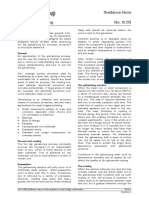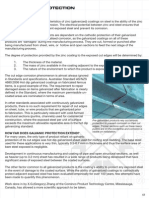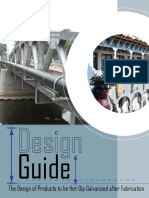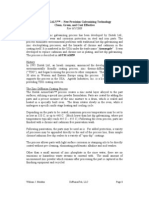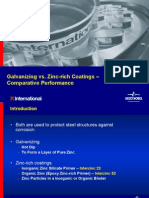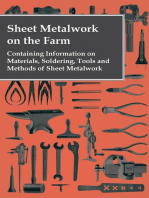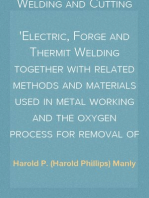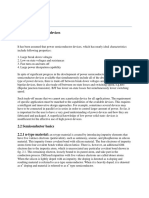BF03220301
BF03220301
Uploaded by
Sontosh BhattacharjeeCopyright:
Available Formats
BF03220301
BF03220301
Uploaded by
Sontosh BhattacharjeeCopyright
Available Formats
Share this document
Did you find this document useful?
Is this content inappropriate?
Copyright:
Available Formats
BF03220301
BF03220301
Uploaded by
Sontosh BhattacharjeeCopyright:
Available Formats
Overview
Developments in the Continuous
Galvanizing of Steel
Glenn W. Bush
INTRODUCTION
The performance history of gal- For several decades, galvanized steel has been an engineering material of choice
vanized steels, particularly in the au- for applications demanding corrosion resistance. These zinc-coated steels have a
tomotive industry, has heightened proven history of successful performance in diverse applications, ranging from
demand for both hot-dip galvanized guard rails and garbage cans to agricultural buildings and automotive parts.
and electrogalvanized products. Such Galvanized steel provides low-cost, effective performance by combining the corro-
marketability has led to the commis- sion resistance of zinc with the strength and formability of steel. The zinc coating
sioning ofseveral new galvanizing lines protects the steel from rust and corrosion by providing a barrier layer. When this
in recent years. Still, for this time- layer is broken, it provides continued protection through a "sacrificial" or electro-
honored coating process to remain com- chemical action. The steel provides an inexpensive engineering material with
petitive, researchers are investigating mechanical properties that can be tailored to specific applications.
methods to improve surface appear- CONTINUOUS HOT·DIP GALVANIZING
ance, coating uniformity, corrosion re-
sistance and cost effectiveness. Hot-dip galvanized steel is produced on three different types of continuous
processing lines (Table I), which prepare and coat the steel in one operation. These
lines are distinguished from each other by the method of surface preparation used
for the steel and by whether or not the steel is annealed prior to processing.
Table I. Types of Hot-Dip In the flux (cold) process, the steel is cleaned in an alkaline solution, pickled
Galvanizing Processes lightly and coated with a flux which is dried at 400-500°F prior to galvanizing. The
Distinguishing Features steel being coated is not annealed as part of this process. In the Sendzimir and non-
Type & Surface Preparation oxidizing processes, residual rolling oils are usually burnt off as the steel is heated
Flux* Liquid Cleaning to temperatures as high as 1,200°F. The hot strip is then passed into another
and Pickling furnace where it is annealed and cooled prior to galvanizing. In the anneal-in-line
Sendzimirl process, the steel surface is cleaned by an alkaline solution before it is annealed and
Non-oxidizing! Thermal Cleaning is cooled prior to galvanizing.
and Preheating
Anneal-in-line! Liquid Cleaning
In all ofthese processes, the steel is coated by passing it through a bath of molten
*No annealing zinc and withdrawing it from the bath through a pair of gaseous jets. These jets
tAnnealing blow off the excess molten zinc which adheres to the steel surface and leave a film
of molten zinc of controlled thickness. As this film solidifies, grains or crystals of
solid zinc form, giving the surface the spangled or flowery appearance associated
with hot-dip galvanized products.
The hot-dip products produced by these processes have been used extensively in
agricultural, construction and numerous other applications. These products nor-
mally have relatively thick coatings (5-20 /lm) and are ideal for applications
requiring maximum corrosion resistance.
ELECTROGALVANIZING
Electrogalvanized steel is also produced on continuous processing lines (Figure
1), which prepare and coat the steel in one operation. On these lines, the steel is
cleaned in an alkaline solution and lightly pickled before the coating operation.
None ofthe electrogalvanizing lines include the annealing of the steel as an inte-
gral operation. Electrogalvanizing lines are distinguished from each other by the
type of plating cell used for the coating operation. The cells are called either hori-
zontal, vertical or radial to describe the relative orientation ofthe strip (cathode)
and the anodes during the operation (Figure 2). The cells may use either soluble or
insoluble anodes and either chloride or sulfate-based electrolytes.
In each of the different types of electrogalvanizing lines, the steel is coated by the
electrochemical reduction of metal ions on the surface of the steel. The coating
Cleaner/Rinse Plating Cells
Dual Entry Exit Dual
Pay-off Welder Accumulator Pickle/Rinse Plater Rinse Accumulator Take-up
Figure 1, A schematic drawing of a modern Reels Reels
electrogalvanl:zing line.
34 JOM • August 1989
thickness is controlled by the amount of current applied and the strip speed which Conductor Rolls
determines the residence time in the cells. The resulting deposit has a smooth,
matte-gray appearance and is more uniform in thickness than the coating on a hot- Hold-Down
Rolls
dip product.
Although electrogalvanizing technology has been used on a commercial scale for Strip - - - - - - - l Wringer
many decades, the relatively thin coatings (up to 5 /lm) produced limited its Rolls
application to either interior use or those situations where improved paintability
and/or temporary corrosion resistance were desired.
MARKET HISTORY Anode
Sink Roll
The successful use of hot-dip galvanized steel in its traditional applications led
to a steady market growth throughout the 1950s and 1960s. These markets became
stagnant from 1970 to 1980 (Figure 3). However, in the late 1970s, as automakers Electrolyte - - - " ' t -
began to implement their "5/10" warranty programs (promising no cosmetic
corrosion for five years and no perforation corrosion for 10 years) an enormous
demand was instantaneously created for corrosion-resistant automotive materi- a
als. It was generally accepted that galvanized steel would provide the corrosion
resistance required, and the sale of hot-dip galvanized steel expanded rapidly. Conductor Deflector
Hot-dip products have historically shown some variation in coating thickness Roll Roll
and surface appearance, limiting their potential use in automotive applications.
The variations in coating thickness adversely affected weldability while the vari-
ations in surface appearance were not totally adequate for the very high visibility
applications requiring undistorted gloss and reflectivity. Also, the steel chemis-
tries and thermal cycles used in hot-dip galvanizing did not produce materials with
formability equivalent to that obtainable in identical cold-rolled steels.
These disadvantages of hot-dip galvanized steel led to the development of an Anode Anode
electrogalvanized steel specifically for use in exposed automotive body panels. The Bridge
first large-scale commercial production of this product began in 1976 with the
introduction of a one-side zinc coated product for hoods and fenders. The success
of this product clearly demonstrated the viability of electrogalvanizing as a large
volume commercial coating process. Until that time, over 90% of the galvanized Plating DC Power
Electrolyte Supply
steel shipped had been produced by the hot-dip process. In 1985 and 1986, the steel
industry commissioned five new electrogalvanizing lines, having a combined b
capacity of over 2,000,000 tons, to meet this increased demand (Table II).
This automotive market demand also resulted in extensive developmental pro-
Conductor
grams involving automakers, steel suppliers, pretreatment suppliers and paint
Rolls Anodes
companies to provide adequate supplies of suitable corrosion-resistant materials.
Hot-Dip Galvanizing
DEVELOPMENTS IN GALVANIZED STEEL
i~~~~~j
I I
An early development in hot-dip galvanizing was the incorporation of an in-line
thermal treatment after the coating process to produce an 8-12% iron-zinc alloy c
coated product. The resulting product had a smoother, spangle-free, matte surface Figure 2. Three types of plating cells for
appearance with weldability almost equivalent to cold-rolled steel. This develop- electrogalvanizing. (a) The vertical cell. (b)
ment was a major improvement which extended the use of hot-dip products to The radial cell. (c) The horizontal cell.
many more unexposed applications and to the less-critical exposed applications.
Initially, the thermal process utilized gas-fired furnaces while a recently developed 8r--------------------,
process employs induction heating of the coated steel.
A second major development was the use of special chemistry, or interstitial-free 7
(IF), steels and the processing ofthose steels on existing hot-dip galvanizing lines
to improve formability. A galvanizing line constructed recently overseas even
utilizes a full, continuous sheet annealing process prior to coating to produce steels 6
with superior formability. Hot-Dip Galvanizing
Recent developments in the coating process include improved tracking and (All Markets)
5
shape control of the strip as it passes through the coating control jets, the use of U)
c
high-volume, low-pressure gaseous jets, and the use of nitrogen as the wiping gas
0
l-
and as a shroud or cover for the zinc pot. These improvements permit the e
U) 4
c
production of a smoother surface with a more uniform coating thickness. ~
~
Electrogalvanizing 3 3,060,000
A major development in electrogalvanizing has been the introduction of alloy
coating processes. Presently, both 15% iron-zinc and 12% nickel-zinc coated pro- 2,260,000 2,070,000
2
ducts for automotive applications are being produced to reduce processing costs by '- 2,050,000
providing thinner coatings with superior weldability and paintability as well as Hot-Dip Galvanizing 1,430,000
corrosion resistance at least equivalent to the thicker, pure zinc coatings. (Automotive) 900,000
Dual-layer and composite coatings are the second major development in elec- 396,000 572 ,000 700,000
trogalvanizing. Dual-layer coatings consist of a very thin electrodeposited surface 219,000 f Electrogalvanizing
layer applied to the surface of a thicker electrodeposited coating. The purpose of o 52400 310,0/ 460,000 (Automotive)
these coatings is to modify the product surface to improve paintability while 1950 1960 1970 1980 1990
retaining desirable characteristics such as the weldability of the thicker coating. Year
An example is a 90% iron-zinc coating applied over a 12% iron-zinc coating. Figure 3. Shipments of galvanized steel,
A composite coating is an organic coating applied over a thinner electrodeposited according to annual statistical reports of the
coating. The purpose of these coatings is to provide improved corrosion resistance American Iron and Steel Institute.
1989 August • JOM 35
You might also like
- Project Report On Galvanisation PlantDocument6 pagesProject Report On Galvanisation PlantEIRI Board of Consultants and Publishers100% (1)
- Surface Prepairation STD For PC ASTM D6386Document4 pagesSurface Prepairation STD For PC ASTM D6386Rohit SangwanNo ratings yet
- Hot Dip Galvanizing Design ConsiderationsDocument10 pagesHot Dip Galvanizing Design ConsiderationsAndreasNo ratings yet
- Zinc CoatingsDocument16 pagesZinc CoatingsShojikuriakoseT100% (2)
- Defects in GalvanizingDocument10 pagesDefects in GalvanizingBalaji GuruNo ratings yet
- Workshop 16 Thermal-Stress Analysis of Intersecting Pipes: ContinueDocument21 pagesWorkshop 16 Thermal-Stress Analysis of Intersecting Pipes: ContinueNguyen Trong HoNo ratings yet
- Indian Galvanised & Colour Coated Steel IndustryDocument7 pagesIndian Galvanised & Colour Coated Steel IndustryPrakash BharatiNo ratings yet
- Zinc CoatingsDocument12 pagesZinc CoatingsvvgdreamNo ratings yet
- MEE 515 AssignmentDocument6 pagesMEE 515 Assignmentadams sundayNo ratings yet
- Design of Products To Be Hot-Dip Galvanized After FabricationDocument28 pagesDesign of Products To Be Hot-Dip Galvanized After FabricationArlet BibriescaNo ratings yet
- Paint GalvanizedDocument7 pagesPaint GalvanizedDwi SutiknoNo ratings yet
- CH 01.07 Galvin SteelDocument5 pagesCH 01.07 Galvin Steelkhairul ardyNo ratings yet
- Improving The Sink Roll Life in Galvalume Using Material AT101 & The Various Thermal-Spray Coating On SS3l6L Roll SurfaceDocument5 pagesImproving The Sink Roll Life in Galvalume Using Material AT101 & The Various Thermal-Spray Coating On SS3l6L Roll SurfaceAnil SharmaNo ratings yet
- 01 007 CCM Cable Support SystemDocument24 pages01 007 CCM Cable Support SystemAlan Tan Y RNo ratings yet
- A - Galvanised Steel As A Substrate For Paint-2016Document3 pagesA - Galvanised Steel As A Substrate For Paint-2016Phạm Anh TuấnNo ratings yet
- Improving The Sink Roll Life in GalvalumeDocument6 pagesImproving The Sink Roll Life in GalvalumePraful PatilNo ratings yet
- ACA Kingfield Site Visit - Hot Dip GalvanizingDocument60 pagesACA Kingfield Site Visit - Hot Dip Galvanizingseii.chenNo ratings yet
- Hot Dip Galvanising 1Document12 pagesHot Dip Galvanising 1Alex LevinNo ratings yet
- Hot Dipping / Galvanizing Process: Manufacturing Process I S.E. Production Unit-VDocument18 pagesHot Dipping / Galvanizing Process: Manufacturing Process I S.E. Production Unit-Vsample use100% (1)
- Aming Members Sept 04Document16 pagesAming Members Sept 04Edison BecerraNo ratings yet
- Module Inspection of HDG On SteelDocument110 pagesModule Inspection of HDG On Steelmus3b1985No ratings yet
- GN - 8 03 SecureDocument6 pagesGN - 8 03 Securebalal moughalNo ratings yet
- Design Guide Galvanized Steel StructuresDocument28 pagesDesign Guide Galvanized Steel StructuresLuis MundacaNo ratings yet
- Guidelines for Welding Galvanized SteelDocument9 pagesGuidelines for Welding Galvanized SteelsinanicikNo ratings yet
- Thermal Spray Coating For Steel ProcessingDocument5 pagesThermal Spray Coating For Steel ProcessingRamkiyengar100% (1)
- Galvannealed Ga Galvanealed Zinc Fe Zinc Ro Zinc Iron Alloy A Practical StudyDocument12 pagesGalvannealed Ga Galvanealed Zinc Fe Zinc Ro Zinc Iron Alloy A Practical StudyashishsteelNo ratings yet
- Metal Roofing From A To Z - Section2 - Metallic CoatingsDocument10 pagesMetal Roofing From A To Z - Section2 - Metallic CoatingsAlcides Gabriel Armas PerezNo ratings yet
- GALV - Cut Edge ProtectionDocument5 pagesGALV - Cut Edge ProtectionHarry Aldous100% (1)
- Ferrous Metals - Galvanized Iron SteelDocument9 pagesFerrous Metals - Galvanized Iron SteelKenneth ChuaNo ratings yet
- Chatterjee: Hot Dip Galvanizing Chatterjee: Hot Dip GalvanizingDocument19 pagesChatterjee: Hot Dip Galvanizing Chatterjee: Hot Dip GalvanizingRupak PanjaNo ratings yet
- G A L V A N I Z I N GDocument10 pagesG A L V A N I Z I N GAPRIL KATE BAGLANNo ratings yet
- Design Guide Galvanized Steel StructuresDocument28 pagesDesign Guide Galvanized Steel StructuresDaren NeradNo ratings yet
- New Galvanizing TechnologyDocument4 pagesNew Galvanizing Technologywmaddoxmec100% (1)
- G - Note3 - The Continuous Electroplating Process ForDocument4 pagesG - Note3 - The Continuous Electroplating Process Formàrio ferreiraNo ratings yet
- HDG High Performance Steels Weldments Doug RourkeDocument28 pagesHDG High Performance Steels Weldments Doug Rourkemàrio ferreiraNo ratings yet
- Protective Coatings For MetalsDocument53 pagesProtective Coatings For MetalsSiddharth Khorwal50% (2)
- Corrosion Resistance Weld Overlay CladdingDocument4 pagesCorrosion Resistance Weld Overlay CladdingiJordanScribdNo ratings yet
- 2012v11 - Taking A Dip - Hot-Dip Galvanizing PDFDocument3 pages2012v11 - Taking A Dip - Hot-Dip Galvanizing PDFabcd_iluNo ratings yet
- Bahan Konstruski Dan Korosi - Pertemuan 14Document40 pagesBahan Konstruski Dan Korosi - Pertemuan 14AuliaMukadisNo ratings yet
- Anodizing of Aluminum by Charles A. Grubbs: CAG Consulting, Lakeland, FLDocument11 pagesAnodizing of Aluminum by Charles A. Grubbs: CAG Consulting, Lakeland, FLpunkassbobNo ratings yet
- 9 Information Series Casting of Stainless SteelDocument6 pages9 Information Series Casting of Stainless SteelDgk RajuNo ratings yet
- Aluminiumand ItsalloysDocument17 pagesAluminiumand ItsalloysRajesh BhushanNo ratings yet
- Astm A 902 2013 PDFDocument8 pagesAstm A 902 2013 PDFCarlos GuerraNo ratings yet
- Guidelines For Welding Galvanized SteelDocument9 pagesGuidelines For Welding Galvanized SteelAhmed AllamNo ratings yet
- Coated Steel Demand To Recover The Past Slump: FocusDocument4 pagesCoated Steel Demand To Recover The Past Slump: FocusPrakash BharatiNo ratings yet
- HDG Fact Sheet 2017 V4Document6 pagesHDG Fact Sheet 2017 V4Ra'oufAli-zadehNo ratings yet
- AnodizingDocument13 pagesAnodizingRatheesh VidyadharanNo ratings yet
- Galvalume Coated Steel Sheet: GalvinfonoteDocument4 pagesGalvalume Coated Steel Sheet: GalvinfonoteHarshith Rao VadnalaNo ratings yet
- Fasteners Zinc CoatedDocument6 pagesFasteners Zinc CoatedAndres Camilo Benitez100% (1)
- AluminiumDocument45 pagesAluminiumravisankar varadharajalu0% (1)
- Hot Dip Galvanized CoatingDocument28 pagesHot Dip Galvanized CoatingOci Rizal100% (7)
- Report Bhushan SteelDocument16 pagesReport Bhushan Steelshweta_770587No ratings yet
- Hot Dip GalvanizingDocument38 pagesHot Dip Galvanizingtmmsekar100% (1)
- Gavalnise Vs PaintsDocument35 pagesGavalnise Vs Paintsian1000100% (2)
- Sheet Metalwork on the Farm - Containing Information on Materials, Soldering, Tools and Methods of Sheet MetalworkFrom EverandSheet Metalwork on the Farm - Containing Information on Materials, Soldering, Tools and Methods of Sheet MetalworkNo ratings yet
- Oxy-Acetylene Welding and Cutting: Electric, Forge and Thermit Welding together with related methods and materials used in metal working and the oxygen process for removal of carbonFrom EverandOxy-Acetylene Welding and Cutting: Electric, Forge and Thermit Welding together with related methods and materials used in metal working and the oxygen process for removal of carbonNo ratings yet
- Oxy-Acetylene Welding and Cutting Electric, Forge and Thermit Welding together with related methods and materials used in metal working and the oxygen process for removal of carbonFrom EverandOxy-Acetylene Welding and Cutting Electric, Forge and Thermit Welding together with related methods and materials used in metal working and the oxygen process for removal of carbonNo ratings yet
- 55% Al-Zn-Alloy-Coated Sheet SteelDocument14 pages55% Al-Zn-Alloy-Coated Sheet SteelSontosh BhattacharjeeNo ratings yet
- Hydraulic Removal Coupling Hubs-Keyed KeylessDocument8 pagesHydraulic Removal Coupling Hubs-Keyed KeylessSontosh BhattacharjeeNo ratings yet
- IntegrationDocument3 pagesIntegrationSontosh BhattacharjeeNo ratings yet
- 1149 BearingsDocument5 pages1149 BearingsSontosh BhattacharjeeNo ratings yet
- Plane Geometry (Ans)Document9 pagesPlane Geometry (Ans)Sontosh BhattacharjeeNo ratings yet
- Disclosure To Promote The Right To InformationDocument29 pagesDisclosure To Promote The Right To InformationgovimanoNo ratings yet
- Cambridge International Science Practical With Written Exam Schedule ChattogramDocument7 pagesCambridge International Science Practical With Written Exam Schedule ChattogramSontosh BhattacharjeeNo ratings yet
- What Is Prepainted Galvanized Steel Coil - Designing BuildingsDocument2 pagesWhat Is Prepainted Galvanized Steel Coil - Designing BuildingsSontosh BhattacharjeeNo ratings yet
- Imparting Resistance To Storage Stain: GalvinfonoteDocument3 pagesImparting Resistance To Storage Stain: GalvinfonoteSontosh BhattacharjeeNo ratings yet
- Finishing 19Document5 pagesFinishing 19Sontosh BhattacharjeeNo ratings yet
- GalvInfoNote 4-2Document8 pagesGalvInfoNote 4-2Sontosh BhattacharjeeNo ratings yet
- Advantages of WeldingDocument1 pageAdvantages of WeldingSontosh BhattacharjeeNo ratings yet
- Calculation of The Collapse Load of An ADocument13 pagesCalculation of The Collapse Load of An ALuminita GeorgetaNo ratings yet
- Skin Mechanical Properties - ArinSDocument26 pagesSkin Mechanical Properties - ArinSJack Flow ClickNo ratings yet
- LEEA Correspondence Courses: Assignment 1.8Document3 pagesLEEA Correspondence Courses: Assignment 1.8Primelift Safety Resources LimitedNo ratings yet
- Post Tension Design of SlabDocument39 pagesPost Tension Design of SlabVikram Jain100% (1)
- BBE 4404 Lab Report - Physical Properties and TensileDocument12 pagesBBE 4404 Lab Report - Physical Properties and TensileIsaac DavyNo ratings yet
- Chapter 8 SolderingDocument19 pagesChapter 8 Solderingarkarminkhant734No ratings yet
- TDS - Marlex® HHM 5502BN PolyethyleneDocument1 pageTDS - Marlex® HHM 5502BN PolyethyleneindahNo ratings yet
- Guided and Leaky Modes of Circular PhDThesis by KimDocument226 pagesGuided and Leaky Modes of Circular PhDThesis by KimsuperbuchNo ratings yet
- Unequal Angles... BS EN 10056-1:1999: BSI ShopDocument3 pagesUnequal Angles... BS EN 10056-1:1999: BSI ShopPrayogo Hadi SNo ratings yet
- 4.1 - Heat TransferDocument28 pages4.1 - Heat TransferHONG XIANo ratings yet
- Size EnlargementDocument31 pagesSize EnlargementGladiador EdinsonNo ratings yet
- Chemical Reaction Engineering Ii - Che471Document62 pagesChemical Reaction Engineering Ii - Che471EmmanuelNo ratings yet
- Particle-Size Reduction - Chemical Engineering - Page 1Document7 pagesParticle-Size Reduction - Chemical Engineering - Page 1Rahul ChandrawarNo ratings yet
- EMT 272 Semiconductor Fundamentals Semiconductor Physics: PN JunctionDocument39 pagesEMT 272 Semiconductor Fundamentals Semiconductor Physics: PN Junctionayuni2602No ratings yet
- Mosfet EbdDocument9 pagesMosfet EbdSrikanth PudhariNo ratings yet
- Lec 4Document5 pagesLec 4Ghazy alshyalNo ratings yet
- Biaxial Bending Moment Magnifier MethodDocument13 pagesBiaxial Bending Moment Magnifier MethodBhavin SolankiNo ratings yet
- Handbook of Micro & Nano Tribology (2nd Edition) (1999 Bharat Bhushan Editor CRC Press)Document855 pagesHandbook of Micro & Nano Tribology (2nd Edition) (1999 Bharat Bhushan Editor CRC Press)Alexandre Pereira100% (2)
- Chapter 2Document54 pagesChapter 2Ankit SinghNo ratings yet
- ME 333 Topic 7 - Radiation Heat TransferDocument21 pagesME 333 Topic 7 - Radiation Heat TransferVinNo ratings yet
- Dryness Fraction PDFDocument3 pagesDryness Fraction PDFPrasant RaoNo ratings yet
- Beam Bending FormulaDocument22 pagesBeam Bending FormulaBeniamine SarmientoNo ratings yet
- Plastics Packaging Technology: PVC Material For Packaging & Testing Methods For Packaging MaterialsDocument17 pagesPlastics Packaging Technology: PVC Material For Packaging & Testing Methods For Packaging MaterialsAnshul GautampurkarNo ratings yet
- Seismic Shear Strength of Columns With Interlocking Spiral Reinforcement Gianmario BenzoniDocument8 pagesSeismic Shear Strength of Columns With Interlocking Spiral Reinforcement Gianmario Benzonijuho jungNo ratings yet
- PR 24Document1 pagePR 24NguyễnBìnhPhươngNo ratings yet
- Me (3) - 2Document16 pagesMe (3) - 2aviralNo ratings yet
- Jjap Express Letter: P-Gan Contact Pd/Au ZroDocument3 pagesJjap Express Letter: P-Gan Contact Pd/Au ZroBillieNo ratings yet
- LGD10703 Engineering ScienceDocument7 pagesLGD10703 Engineering ScienceHafizuddin RazakNo ratings yet





















